‘Like a residents’ association meeting’
The atmosphere was relatively calm in July 2009, when the judges of the High and Supreme Courts met for their annual conference in Adare, Co Limerick. The agenda was the standard list of topics related to the admistration of the courts.
“It’s always like a residents’ association meeting, where all the usual cranks stand up and complain about litter on the streets. It’s indistinguishable from that,” says one reluctant participant. But on this occasion the agenda also included a topic that had been exercising senior judges for months: gowns.
The chief justice, Mr Justice John Murray, had wanted for some time to introduce new, European-style judicial attire, to replace the old British-influenced garb the judges had been wearing since Hugh Kennedy's abortive attempt, as chief justice, to replace it in the 1920s.
The designer Louise Kennedy was commissioned to do the job, and she made several visits to the Supreme Court conference room in the first half of 2009 to show them different options. This had got back to government. "They're down there talking about new wigs and gowns, or no wigs and new gowns. I was thinking, Jesus, Mary and Joseph!" says one former minister. "I just felt some of these people didn't live in the real world as regards what was coming down the tracks."
At the Adare meeting two High Court judges, Mary Irvine and Peter Charleton, paraded around the room, modelling the new designs, before it was agreed that there should be further consultation before a final decision was made at the conference of the entire judiciary that November.
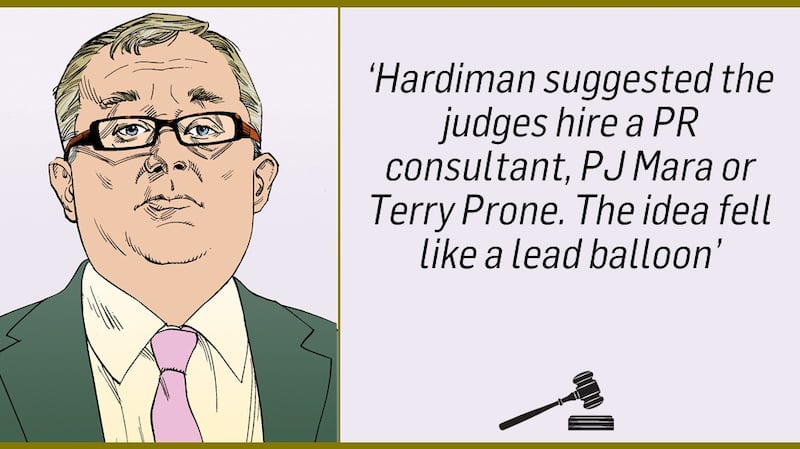
As the meeting was wrapping up Murray went to take a call from Gerry Curran, the media adviser to the Courts Service. When he returned the chief justice told the judges that a story was about to break on the RTÉ evening news that only 19 judges out of 148 had so far availed of a scheme agreed between the judiciary and Revenue to allow judges to make a voluntary contribution in lieu of a pension levy imposed on all other public servants.
At first the room went silent. The issue had divided judges for months; some insisted that everyone had to pay, but a minority were adamant that they wouldn’t. A few months earlier one senior judge told a more junior colleague that it was important to pay, because worse could follow if they didn’t. The second judge accused him of behaving like Stalin, prompting the more senior man to threaten to resign if the remark was not retracted. Many more such threats were to follow.
Those around the table in Adare felt aggrieved; they had until the end of the year to make the voluntary payment, and many of them had planned to do so when they filed their tax return in October.
A statement making that point was hurriedly issued. But the judges knew that, for all they might argue about the unfairness of the story, this was going to look terrible.
They were right. The story dominated the news the next day. Mary Harney, the minister for health, said she was disappointed by the low take-up and said she believed the judiciary would respond and “show solidarity with those people that are losing their jobs and people who had to take a big hit in their incomes”. Her cabinet colleague Willie O’Dea, the minister for defence, said that the judges were setting a poor example.
Government ministers were not just trying to channel the public mood. They needed the judiciary to play ball if they were not to stand accused of having gone too easy on the high earners at the Four Courts. Now the government was in the line of fire.
In the ensuing clamour the Fianna Fáil TD Niall Collins stepped forward and made a proposal: if the Constitution blocked the government from imposing the pension levy on the judges, why not hold a referendum to change it? At that stage it was an isolated call.
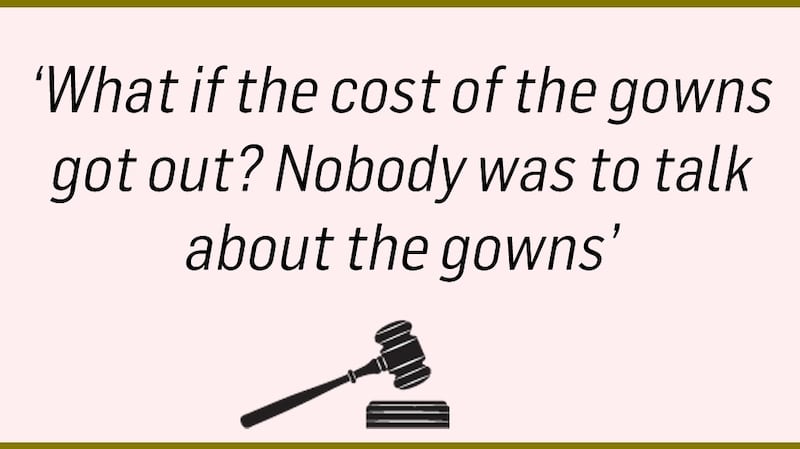
On the Monday after the Adare conference a tense meeting was held in the Supreme Court conference room. Murray brought in a sheaf of negative press clippings, and after some complaints around the table about how unfair the coverage was the group discussed what to do.
Ultimately they agreed that Murray would put out a statement correcting the more egregious misrepresentations. He spent the day working on it. Later, at lunch, the group discussed an email that Adrian Hardiman, who had been a Supreme Court judge since 2000, had circulated earlier in the day suggesting that the judges should hire a PR consultant, such as PJ Mara or Terry Prone, to make their case in public. The idea fell like a lead balloon.
In his statement Murray took issue with “unfair and misleading” statements about the issue, adding that he felt there would be “strong and continuous participation” in the scheme. Brian Cowen, the taoiseach, then came to the judges’ aid, welcoming Murray’s statement and saying that it was “not correct” to say that judges who had not yet made a contribution “have refused to do so”.
But the criticism grew louder. Judges visited each other’s chambers to exchange stories about the abuse they were getting: one had fruit thrown at his car in the judges’ yard by someone who yelled that he should pay his “f***ing pension levy”.
A story emerged from the criminal courts on Parkgate Street, where a judge, when he apologised to a jury about the absence of a facility, was told: “If you judges had paid your pension levy this mightn’t have happened.”
Increasingly, the judges were of one mind on one point at least: if only the government had simply imposed the pension levy on them it would have saved everyone a lot of grief.
The general air of gloom in judges’ chambers grew darker still when, within days of the news of the low take-up, Dearbhail McDonald, the Irish Independent’s legal-affairs editor, broke the story about the gowns.
“Fashion guru Louise Kennedy has been commissioned by the Chief Justice to create an unprecedented new range of designer robes for the country’s judges,” it began.
The timing could scarcely have been worse. Several judges listened in funereal silence as the story was discussed on Today with Pat Kenny, on RTÉ Radio 1, that morning. Another meeting was called to discuss whether to put out another statement. (They decided against.)
Now the judges were preoccupied with a new concern: what if the cost of the gowns got out? Nobody was to talk about the gowns.
The press was keeping a running tab on the judicial sign-up rate for the voluntary contribution. By September just half of all serving judges – 72 of 144 – had paid. By January the figure was 111.
In private the judiciary was split into two camps. A small minority, led by lower-earning judges in the District Court but including a number from the High Court, complained that they were under financial strain and could not afford to take the hit. (In late 2009 District Court judges earned just under €148,000, Circuit Court judges earned just over €177,500 and High Court judges earned €243,000; Supreme Court judges earned slightly more, at just under €258,000.) At the same time the chief justice and the presidents of the various courts were in turn coming under intense pressure from within their ranks to take a stronger stance against the holdouts.
The High Court judges met for lunch twice a week, one known as the picnic, every Wednesday, when everyone brought their own sandwiches, and a more formal gathering on Fridays, which used to be catered before funding was withdrawn during the recession.
Through late 2009 the pension levy and the public opprobrium being heaped on the judiciary was the only topic of conversation at the lunches.
The mood worsened in December, when The Irish Times published an opinion article by Alan Shatter in which he called for a referendum on judicial pay. This was the worst-case scenario in the judges' eyes. But they were reassured by Shatter's apparent marginalisation under Enda Kenny's leadership of Fine Gael.
At the time the party’s justice spokesman was the emollient Charlie Flanagan. It was assumed that even if Fine Gael got into government after the next election Shatter was unlikely to become minister for justice and therefore have any chance to act on his idea.
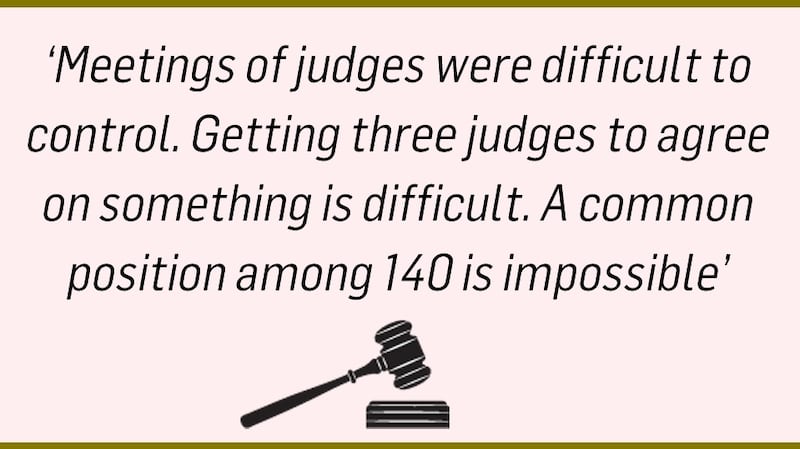
Tensions over the judges’ voluntary contribution simmered through 2010. While the public line was that the decision to pay was each judge’s alone, in private pressure was now being applied to those who had not stumped up.
Eventually, 85 per cent of judges signed up, including everyone in the Supreme Court and all but one in the High Court. But by then it was too late. The slow initial take-up was all that people remembered, and it enabled politicians – one politician in particular, or so it seemed to the judges – to go on the offensive.
By now Shatter had produced a private member’s Bill to allow for a referendum to cut judicial pay. He was proposing that it should be put to the people on the day of the next election. In order to maintain confidence in the judiciary, he said, “it is important they should be seen as part of the community and not an elite set apart”. Thanks to a significant shift in the political landscape Shatter’s voice now carried much more weight.
In June 2010 Kenny’s opponents had mounted a botched heave to remove him from the party leadership. Flanagan threw his weight behind Kenny’s challenger, Richard Bruton, but Shatter remained loyal to the leader.
When a victorious Kenny announced his front-bench reshuffle, in early July, Flanagan was demoted and Shatter became justice spokesman. That put him first in line for the Department of Justice if Fine Gael won the next election.
The Cowen government was disinclined to take up Shatter’s referendum idea, but everything except pay was being slashed. The Courts Service budget was cut, a proposal was circulated to do away with judges’ ushers, and there was talk of longer court sittings.
The budget announced in late 2010 brought two further pieces of bad news for the judges. The first was unintentional. In order to clamp down on company executives who were given multimillion-euro pension pots as a tax-efficient way to effectively top up their pay, the budget limited tax relief to pension funds worth up to €2.3 million.
Although the measure was aimed mainly at senior executives in the private sector, it caught two other categories of people with a mix of public and private pensions: judges and hospital consultants. The result was that a large portion of judges’ pensions would end up being taxed at 73 per cent – enough to virtually wipe out the private pension pots they had been building up since their time at the Bar.
The second budgetary measure was very much deliberate: new appointees to the judiciary would be paid 10 per cent less than incumbents. The idea of a two- tier judiciary – some of those who joined later referred to themselves as the yellow packs – infuriated the judges.
An emergency general meeting of the entire judiciary was called. These meetings were always difficult to control; getting three judges to agree on something is difficult enough, but looking for a common position among 140 of them is an impossible task. By now voices were being raised. The judges were at sea. There was open talk of strikes and mass resignations.
In the spring of 2011 Fine Gael and Labour swept to power with the biggest majority of any government in the history of the State. Relationships got off to a bad start. “We were amazed at the dysfunctionality of the judiciary – how disunited they were,” says one government source.
Groups of judges would adopt a single stance at meetings with ministers and their officials; then, afterwards, individual judges would call “and tell you they disagreed with the [judges’] official position”.
Kenny himself was bemused by the judges. He had a small number of acquaintances in the legal profession, but like Bertie Ahern before him he tended not to mix in legal circles and had a generally low opinion of the Bar. He also knew that many of the Fine Gael barristers had supported Bruton in the 2010 heave. “I don’t know what to make of them,” he told advisers about the judges when tensions were at their height.
With the government making it clear that the referendum would go ahead, positions hardened in the Four Courts, but the judges were at a loss as to how to play the situation.
“None of us had ever gone into a scenario like this. Judges’ incomes had risen over the preceding decade . . . It was happy days. Nobody wanted to give up what had taken so long to bring about. But we needed to give something up, because the ultimate menace was about to descend on us in the form of Shatter, with his loathing of judges and barristers.”
Ministers thought that the judges overplayed the Shatter factor; after all, his plans had wide support in government, notably from the powerful Department of Public Expenditure and Reform under Brendan Howlin. The general sense was that judges were pampered and complacent.
Ministers were also surprised by how bad the judges were at lobbying. At one meeting a senior judge told a cabinet member that many of his colleagues simply could not take a hit on their incomes because they had their children at private schools. “It became clear that they had no real intention of changing anything,” says one senior figure.
The government duly published the proposed wording of the referendum in June, and at around the same time Shatter emailed Murray to inform him that, were the vote carried, pay for new judges would be cut by 31 per cent.
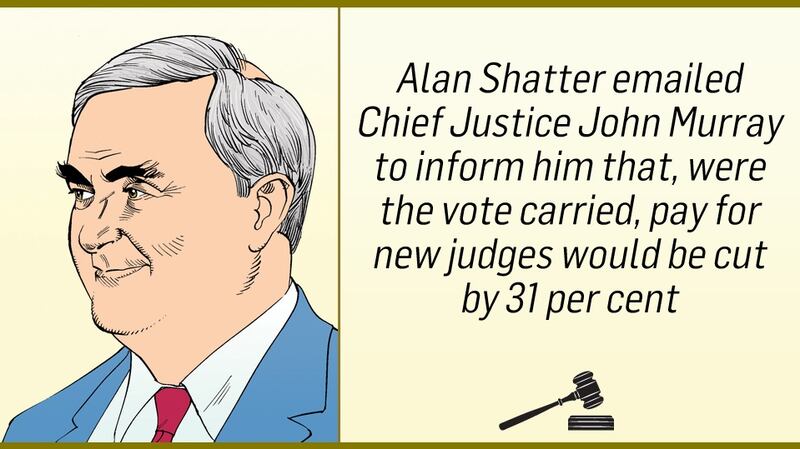
Again the judges went into panic mode. At a hastily convened joint meeting of High and Supreme Court members – about 45 judges – in room 15, a courtroom converted for meetings on the first floor of the Four Courts, there was fury around the table about the fact that they had to read about the amendment wording in the newspapers.
Whelan and Howlin came in for criticism, but Shatter was the focus of the judges' ire. Many of them were convinced that he had a vendetta against them. The upshot of the meeting was that a subcommittee would be set up to draft a submission for government. The subcommittee would comprise two Supreme Court judges, Hardiman and Nial Fennelly, and two from the High Court, George Birmingham and Gerard Hogan.
The anger was still palpable when the same group of judges convened for their summer conference at Farmleigh, in the Phoenix Park, a few days later. By then the subcommittee had drafted a statement setting out the judges’ position, with the intention of issuing it to the media on behalf of the judiciary.
It was a relatively innocuous text. It complained about a lack of contact from government and argued that the amendment as proposed would not protect judicial independence or comply with Ireland’s international obligations. It said that the judiciary was keen to talk to the government about the issue.
By now the judges were not objecting to a referendum, but they wanted the proposal to include an independent body that would set pay rates, thereby taking that power away from government, which they felt would threaten judicial independence.
This was a key point. In the public mind, judges’ objections to the referendum came down to one thing: money. For some of them that was undoubtedly true. In the Supreme and High Courts many judges had taken big pay cuts to join the bench and watched their old colleagues at the Bar take home multiples of what they earned. At the time the highest-earning barristers, who built practices working exclusively for big corporations and financial institutions, could pull in €2 million a year.
But the judges are a diverse group; attitudes varied. Some were in severe financial trouble, having made bad property investments during the boom. Government ministers wondered privately whether one or two senior judges might be close to being insolvent.
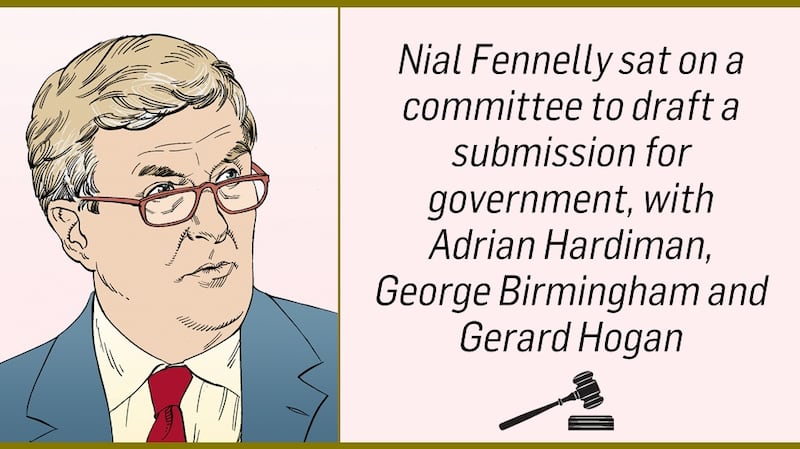
Other judges were particularly put out by what they saw as the unfairness of the pension-lump-sum reform, which was designed to change behaviour in the private sector but as a largely unintended consequence hit judges in such a way that, for some at least, the vast bulk of their pension pots had been emptied at the stroke of a pen.
But there was also a deeper reason for many judges’ anger: the government’s moves hit them right where they have always felt most exposed. One of the United States’ founding fathers, Alexander Hamilton, said that although in theory the three branches of government were equal, in practice the judiciary was the weakest, because it controlled “neither sword nor purse”. It’s a commonly heard axiom among Irish judges.
For all their bravado and self-importance, many judges have an acute sense of their own vulnerability. They have always clung dearly to the two protections that the Constitution provides: the guarantee of independence and the ban on government reducing their pay.
In 2011 the State was involved in almost half the cases that went through the courts. The judges took their decisions – often decisions that cost the State huge amounts of money or caused headaches for ministers and their officials – knowing that, short of impeachment and long-term reconfiguration of the judiciary through the appointments system, there was no way for the government of the day to punish them.
Now, as they saw it, one of those two protections was about to be removed. That was why they wanted an independent salary-setting body to stand between them and the government.
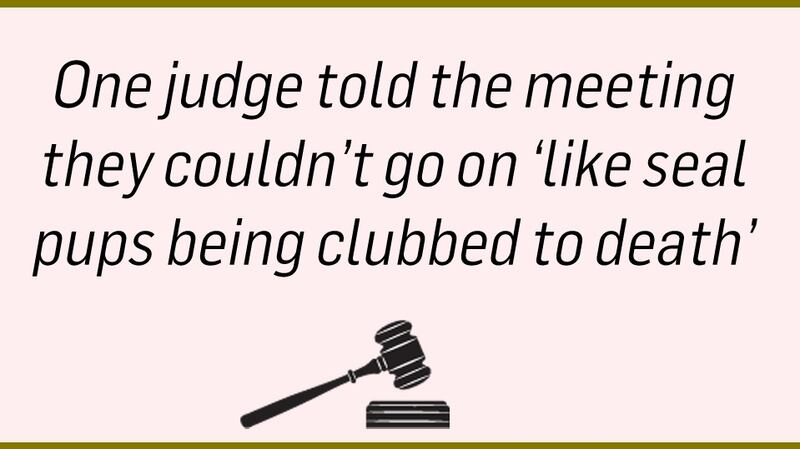
At Farmleigh, pressure on the leadership was intense. Those gathered were aware that a number of Circuit Court judges were threatening legal action. One judge told the meeting they couldn’t go on “like seal pups being clubbed to death on pack ice”. A senior judge warned darkly that all hell would break loose unless a statement went out.
In a small drawing room on the ground floor at Farmleigh the four members of the subcommittee were joined by Murray and Nicholas Kearns, the president of the High Court. They went through the text line by line.
But just as the meeting was about to sign off on it a question was raised: in whose name was it to be issued? Did they need the unanimous agreement of all judges? That was impossible: already one High Court judge had indicated that he wanted to dissent.
Hardiman had been threatening to publish a newspaper article under his own name, but colleagues had talked him out of it. Now he was adamant that the statement should go out, and he suggested that it be issued under the names of Murray and Kearns. Murray wasn’t keen on that.
He told the group that their Supreme Court colleague Susan Denham also had reservations about a statement. That was significant, because, as they all knew, she was the front-runner to succeed Murray, who was due to retire as chief justice the following month. And as the succession date came closer she was steadily gaining in authority.
The judges of the Supreme Court and the High Court were split on whether to issue the statement or go through the traditional lines of communication. Eventually the Farmleigh meeting ended with no decision other than that the statement should be given to the Attorney General.
A few days later, when Shatter gave an interview in which he seemed to rule out any change in the proposed policy, the judges were again up in arms. In a flurry of emails the call went up: the statement had to be released.
An extremely tense meeting of its judges took place in the Supreme Court that morning – one of the most difficult anyone could remember. Murray and Denham were against issuing the statement. Hardiman was in favour and had support from others. Several judges shouted at each other across the conference table.
The problem was that the court didn’t know how to take a decision about what to do. As a collegiate court, did it have to be unanimous or by majority? The exchanges became so heated that one judge threatened to resign there and then, before being talked down.
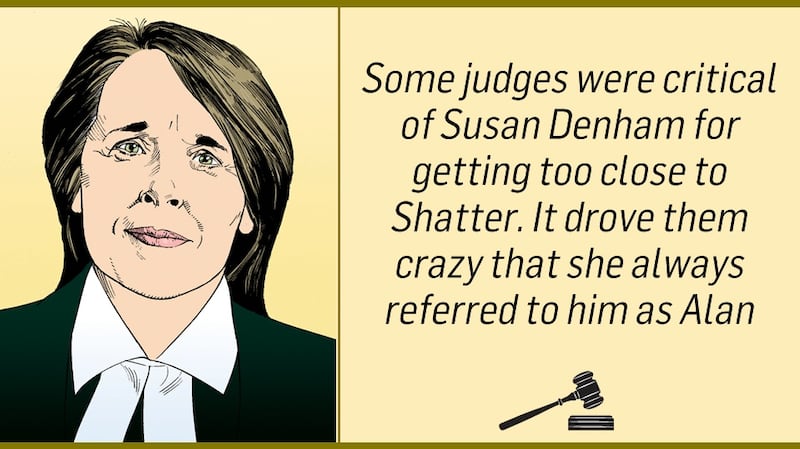
As the end of Murray’s term as chief justice approached, in July 2011, the government’s attention turned to possible replacements. Three names were considered: Denham, Fennelly and Kearns, whose efficient running of the fast-growing High Court had won plaudits.
Another judge lobbied hard for the job. He canvassed ministers, knocked on TDs’ doors at night and went to Co Mayo to approach several people whom he had never met but who happened to be acquainted with the Taoiseach.
One day, in the run-up to the government’s decision, the wife of a senior minister was pushing a trolley along a supermarket aisle when a woman approached her, introduced herself as this judge’s wife and said that he would make a great chief justice.
“His modus operandi was so outrageous that it disqualified him,” says a source. Another judge approached a government adviser and complained that his name had not been mentioned in an Irish Times report about contenders for the post.
In July the cabinet formally signed off on Denham’s appointment as Chief Justice. Within government Denham was widely liked and respected. “There was a general positive feeling about her,” says one well-placed source.
When she had joined the Supreme Court, in 1992, she had been its first woman member. Now, 19 years on, she was to become the first woman (and the first Protestant) to lead the Irish judiciary. One of the new Chief Justice’s first acts was to announce that she would not be taking the €38,000 salary increase that came with the job.
Denham’s preference was for engagement over confrontation. She believed that the judiciary could better influence decisions by quiet, behind-the-scenes contacts than by public rows.
Her problem was that morale was on the floor and that by now there was a sizeable group of judges, which included Kearns, Hardiman and Peter Kelly, who were convinced that the soft approach wasn't working. They now had what one critic called the worst of both worlds: "We got a huge amount of adverse publicity, and we were going to end up with all the cuts that came anyway."
Some judges were critical of Denham for getting too close to Shatter. It drove them crazy that she always referred to him as Alan.
In late summer ministers were told that Hardiman was threatening to resign if the referendum was passed. But it went ahead, and on October 27th, 2011, a proposal to remove the bar on reducing judges’ pay was approved by referendum with 80 per cent support.
“We were beaten into the ground,” says one judge. “Twenty per cent [against]”, says another. “We didn’t know we had that many friends.”
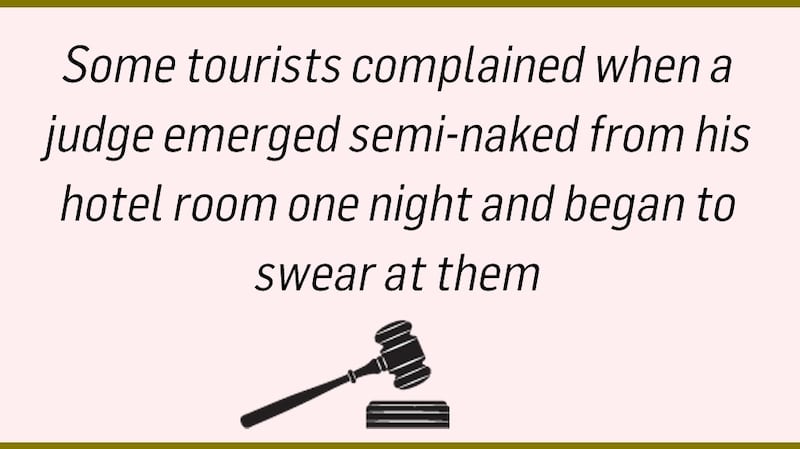
The referendum and the creation of the Association of Judges of Ireland, a representative group driven by Kelly, Kearns, Birmingham and others, took some of the heat out of the relationship between ministers and judges, but it took longer to restore trust.
Issues continued to simmer in the background and occasionally boiled over. Both sides blamed the other, for example, for the delay in introducing a judicial council that would be responsible for judicial conduct, education and training. The idea had been in circulation for almost a decade without any sign of a Bill being passed.
The judges claimed that the government was holding up the plan; cabinet members believed that the judges were resisting because they feared a proposal to have judges make public declarations of their financial interests.
Whatever the reason, the absence of such a body came into sharp focus in 2011, when a complaint was made about a judge behaving inappropriately in a hotel. Some British tourists complained when the man, who was only later identified as a judge, emerged semi-naked from his hotel room one night and began to yell abuse and swear at them for making noise. He was also alleged to have angrily told them that he had relatives in the old IRA who had fought the British.
The incident was first reported to the hotel management and then to the courts. All the senior judges could do was to sit down with the judge over a cup of tea and suggest that he take a rest.
Behind the scenes, in early 2013, advanced discussions were taking place within the judiciary about whether to deploy the nuclear option and sue the State.
The two suggested grounds for a constitutional action were, first, the new differential in pay between judges of the same courts and, second, the reductions in judicial pay generally after the referendum was passed. According to the constitutional amendment, judges’ pay was subject to taxes, levies and charges that were imposed on “persons generally” or “persons belonging to a particular class”.
In the view of some judges the government had not shown how the scale of the cuts to judicial pay was directly referable to another group in the public service. Legal advice was sought from a prominent senior counsel, who told the judges that they had a strong case.
It was agreed that the judiciary should write to the government, asking it to identify another group that had taken a hit of the same scale. If, as the judges expected, the government could not identify that group, then the legal action would proceed. And the judges were convinced that in those circumstances they would win.
Now the judges had a big decision to make. Many of them were convinced they should take the case. Others argued for holding back. For a number of weeks discussions took place within the association and among small groups of judges, advocates on each side trying to bring others around to their position.
“People were very, very nervous about it. Others were not. Others said: bring it on,” says one well-placed source. One concern was the cost involved. The association had no substantial funds of its own, so to take a constitutional action it would have had to seek a contribution of a few thousand euro from every judge.
But the bigger concern was that by suing the State the scene would be set for a sensational public stand-off between two arms of government. “It was going to be a very public – and possibly therefore constitutional – crisis between the judiciary and the executive,” says one source.
In the end the letter was never sent. Instead the executive committee of the Association of Judges of Ireland decided to negotiate with ministers, and ultimately they won a pledge to the effect that the difference in pay between old and new judges would be eroded with the passage of time.
“In the end nobody wanted to send the letter threatening legal action,” says one.
Some judges, dismayed by the association’s decision, threatened to take the case themselves. They never did.
This is an edited extract from The Supreme Court: The Judges, the Decisions, the Rifts and the Rivalries That Have Shaped Ireland, which is published by Penguin Ireland on September 5th. © Ruadhán Mac Cormaic. penguin.ie









